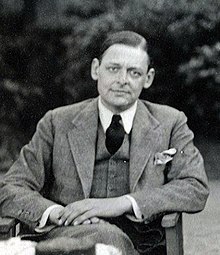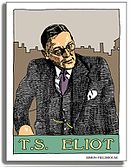
Kubla Khan: or A Vision in a Dream is a poem written by Samuel Taylor Coleridge, completed in 1797 and published in 1816. It is sometimes given the subtitles "A Vision in a Dream" and "A Fragment." According to Coleridge's preface to Kubla Khan, the poem was composed one night after he experienced an opium-influenced dream after reading a work describing Shangdu, the summer capital of the Mongol-led Yuan dynasty of China founded by Kublai Khan. Upon waking, he set about writing lines of poetry that came to him from the dream until he was interrupted by "a person on business from Porlock". The poem could not be completed according to its original 200–300 line plan as the interruption caused him to forget the lines. He left it unpublished and kept it for private readings for his friends until 1816 when, at the prompting of Lord Byron, it was published.

Thomas Stearns Eliot was a poet, essayist, publisher, playwright, literary critic and editor. He is considered to be one of the 20th century's greatest poets, as well as a central figure in English-language Modernist poetry. His use of language, writing style, and verse structure reinvigorated English poetry. He is also noted for his critical essays, which often reevaluated long-held cultural beliefs.

"The Love Song of J. Alfred Prufrock", commonly known as "Prufrock", is the first professionally published poem by American-born British poet T. S. Eliot (1888–1965). The poem relates the varying thoughts of its title character in a stream of consciousness. Eliot began writing "Prufrock" in February 1910, and it was first published in the June 1915 issue of Poetry: A Magazine of Verse at the instigation of fellow American expatriate Ezra Pound. It was later printed as part of a twelve-poem chapbook entitled Prufrock and Other Observations in 1917. At the time of its publication, "Prufrock" was considered outlandish, but the poem is now seen as heralding a paradigmatic shift in poetry from late 19th-century Romanticism and Georgian lyrics to Modernism.
"Gerontion" is a poem by T. S. Eliot that was first published in 1920 in Ara Vos Prec and Poems. The title is Greek for "little old man," and the poem is an interior monologue relating the opinions and impressions of an elderly man, which describes Europe after World War I through the eyes of a man who has lived most of his life in the 19th century. Two years after it was published, Eliot considered including the poem as a preface to The Waste Land, but was talked out of this by Ezra Pound. Along with "The Love Song of J. Alfred Prufrock" and The Waste Land, and other works published by Eliot in the early part of his career, '"Gerontion" discusses themes of religion, sexuality, and other general topics of modernist poetry.

"Journey of the Magi" is a 43-line poem written in 1927 by T. S. Eliot (1888–1965). It is one of five poems that Eliot contributed for a series of 38 pamphlets by several authors collectively titled the Ariel Poems and released by the British publishing house Faber and Gwyer. Published in August 1927, "Journey of the Magi" was the eighth in the series and was accompanied by illustrations drawn by American-born avant garde artist Edward McKnight Kauffer (1890–1954). The poems, including "Journey of the Magi", were later published in both editions of Eliot's collected poems in 1936 and 1963.

Thomas Ernest Hulme was an English critic and poet who, through his writings on art, literature and politics, had a notable influence upon modernism. He was an aesthetic philosopher and the 'father of imagism'.

Divine Mercy Sunday is a feast day that is observed in the Roman Rite calendar, as well as some Anglo-Catholics of the Church of England. It is celebrated on the Second Sunday of Easter, which concludes the Octave of Easter. It is originally based on the Catholic devotion to the Divine Mercy that Faustina Kowalska reported as part of her encounter with Jesus, and is associated with special promises from Jesus and indulgences issued by the Catholic Church.

"The Hollow Men" (1925) is a poem by the modernist writer T. S. Eliot. Like much of his work, its themes are overlapping and fragmentary, concerned with post–World War I Europe under the Treaty of Versailles, hopelessness, religious conversion, redemption and, some critics argue, his failing marriage with Vivienne Haigh-Wood Eliot. It was published two years before Eliot converted to Anglicanism.
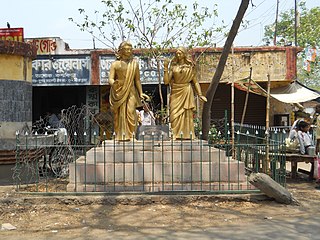
Vaiṣṇava Sahajiyā was a form of Hindu tantric Vaishnavism focused on Radha Krishna worship that developed in Eastern India. This tradition flourished from the 16th to the 19th century. The Vaiṣṇava Sahajiyā tradition produced many great poets who wrote in the Bengali language, the most famous of these poets all wrote under the pen name Chandidas. Their religious literature was mainly written in Bengali vernacular.

"Ode: Intimations of Immortality from Recollections of Early Childhood" is a poem by William Wordsworth, completed in 1804 and published in Poems, in Two Volumes (1807). The poem was completed in two parts, with the first four stanzas written among a series of poems composed in 1802 about childhood. The first part of the poem was completed on 27 March 1802 and a copy was provided to Wordsworth's friend and fellow poet, Samuel Taylor Coleridge, who responded with his own poem, "Dejection: An Ode", in April. The fourth stanza of the ode ends with a question, and Wordsworth was finally able to answer it with seven additional stanzas completed in early 1804. It was first printed as "Ode" in 1807, and it was not until 1815 that it was edited and reworked to the version that is currently known, "Ode: Intimations of Immortality".
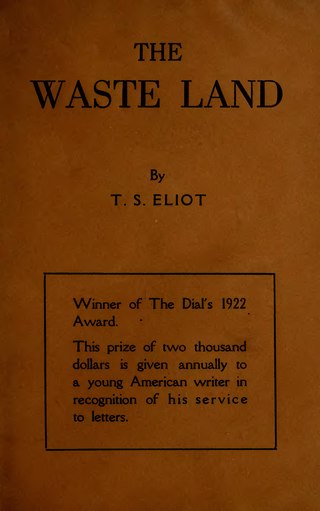
The Waste Land is a poem by T. S. Eliot, widely regarded as one of the most important English-language poems of the 20th century and a central work of modernist poetry. Published in 1922, the 434-line poem first appeared in the United Kingdom in the October issue of Eliot's magazine The Criterion and in the United States in the November issue of The Dial. Among its famous phrases are "April is the cruellest month", "I will show you fear in a handful of dust", and "These fragments I have shored against my ruins".
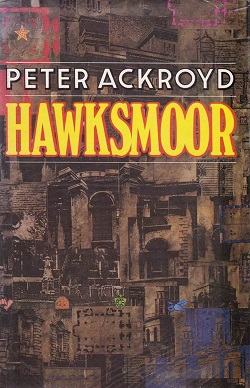
Hawksmoor is a 1985 novel by English writer Peter Ackroyd. It won Best Novel at the 1985 Whitbread Awards and the Guardian Fiction Prize. It tells the parallel stories of Nicholas Dyer, who builds seven churches in 18th-century London for which he needs human sacrifices, and Nicholas Hawksmoor, detective in the 1980s, who investigates murders committed in the same churches. Hawksmoor has been praised as Peter Ackroyd's best novel and an example of postmodernism.
East Coker is the second poem of T. S. Eliot's Four Quartets. It was started as a way for Eliot to get back into writing poetry and was modelled after Burnt Norton. It was finished during early 1940 and printed in the UK in the Easter edition of the 1940 New English Weekly, and in the US in the May 1940 issue of Partisan Review. The title refers to a village in Somerset that was connected to his Eliot family ancestry and where St Michael and All Angels' Church, East Coker was later to house Eliot's ashes.
Little Gidding is the fourth and final poem of T. S. Eliot's Four Quartets, a series of poems that discuss time, perspective, humanity, and salvation. It was first published in September 1942 after being delayed for over a year because of the air-raids on Great Britain during World War II and Eliot's declining health. The title refers to a small Anglican community in Little Gidding in Huntingdonshire, established by Nicholas Ferrar in the 17th century and scattered during the English Civil War.
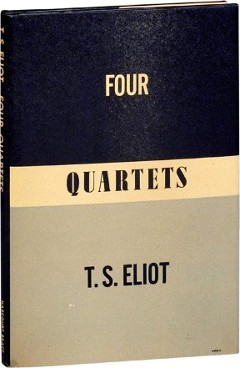
Four Quartets is a set of four poems written by T. S. Eliot that were published over a six-year period. The first poem, Burnt Norton, was published with a collection of his early works. After a few years, Eliot composed the other three poems, East Coker, The Dry Salvages, and Little Gidding, which were written during World War II and the air-raids on Great Britain. They were first published as a series by Faber and Faber in Great Britain between 1940 and 1942 towards the end of Eliot's poetic career. The poems were not collected until Eliot's New York publisher printed them together in 1943.

Burnt Norton is the first poem of T. S. Eliot's Four Quartets. He created it while working on his play Murder in the Cathedral, and it was first published in his Collected Poems 1909–1935 (1936). The poem's title refers to the manor house Eliot visited with Emily Hale in the Cotswolds. The manor's garden serves as an important image within the poem. Structurally, the poem is based on Eliot's The Waste Land, with passages of the poem related to those excised from Murder in the Cathedral.

Little Gidding is a small village and civil parish in Cambridgeshire, England. It lies approximately 9 miles (14 km) northwest of Huntingdon, near Sawtry, within Huntingdonshire, which is a district of Cambridgeshire as well as a historic county.

Peter Ackroyd is an English biographer, novelist and critic with a specialist interest in the history and culture of London. For his novels about English history and culture and his biographies of, among others, William Blake, Charles Dickens, T. S. Eliot, Charlie Chaplin and Sir Thomas More, he won the Somerset Maugham Award and two Whitbread Awards. He is noted for the volume of work he has produced, the range of styles therein, his skill at assuming different voices, and the depth of his research.

The T. S. Eliot bibliography contains a list of works by T. S. Eliot.
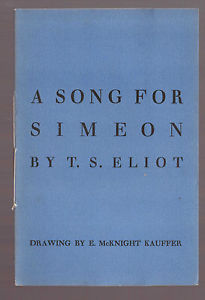
"A Song for Simeon" is a 37-line poem written in 1928 by American-English poet T. S. Eliot (1888–1965). It is one of five poems that Eliot contributed to the Ariel Poems series of 38 pamphlets by several authors published by Faber and Gwyer. "A Song for Simeon" was the sixteenth in the series and included an illustration by avant garde artist Edward McKnight Kauffer. The poems, including "A Song for Simeon", were later published in both the 1936 and 1963 editions of Eliot's collected poems.
